 Image search results - "boats" Image search results - "boats" |

Empty rowboats too.
|
|
|
|

Rowboats and low-hanging cherries.
|
|

How it looks from the end of the moat.
|
|

How it looks from the end of the moat.
|
|
|

By 6 pm, shrine parishioners started boarding boats near Tenjin-bashi Bridge, the starting point of the Boat Procession. These are supporter's boats.
|
|

These boats will carry portable shrines.
|
|

A large crane is used to carry the portable shrines onto the boats.
|
|

The Boat Procession started at 7 pm on Okawa River. These boats are called Dondoko. どんどこ船 大川 船渡御
|
|

The Boat Procession (Funa-togyo) is the Tenjin Matsuri festival's main event.
|
|
|
|

The boats are numerous. About 100 of them go up and down the river.
|
|

Most of the boats carry parishioners who eat bento on the boats while sometimes looking at photographers shooting them from a bridge overhead.
|
|

Okawa River 大川
|
|

The boats are large barges.
|
|

To ride these boats, you have to be a member of a shrine parish or supporting group.
|
|

船渡御
|
|
|

The fire, fueled by LP gas, is on a corporate-sponsored boat, used for illumination. 大篝
|
|
|

Tugboats pull these huge barges.
|
|

Ningyo-bune 人形船
|
|
|
|
|

Boat corner
|
|
|
|
|
|

船渡御
|
|

船渡御
|
|
|
|
|
|

The boat carrying the portable shrine housing the spirit of Sugawara Michizane. 御鳳輦奉安船
|
|

This is the most important boat in the procession. It holds a ceremony called the Senjo-sai (船上祭) in the middle of the river to celebrate Sugawara Michizane's birthday. 御鳳輦奉安船
|
|

玉御神輿奉安
|
|

Portable shrine 船渡御 玉御神輿奉安
|
|

Horrendous crowd gathers to watch the fireworks, the festival's climax. The festival ends at 10 pm when the procession returns to the shrine.
|
|

From July 1 to Sept. 23, Arashiyama also has ukai cormorant fishing. Buy your tickets at this booth slightly upstream from Togetsukyo Bridge.
|
|

The ukai cormorant boats operate twice each evening at 7 pm and 8 pm (6:30 pm and 7:30 pm in Sept.). ¥1,800 for adults and ¥900 for kids age 4–12.
|
|

On board a yakata-bune to view ukai cormorant fishing. Fits about 10 people.
|
|

The boats are hitched together.
|
|

Gifu is not the only place where you can see ukai cormorant fishing.
|
|

Ukai cormorant fishing on the river at Arashiyama was quite enjoyable. It's cheaper than in Gifu, and the cormorants passed by maybe 6 times.
|
|

Yakata-bune boat steerer.
|
|
|
|
|

Leaving Nagahama.
|
|
|
|

Lead boat
|
|

Rowing past Nagahama Dome, a sports and event complex.
|
|

Rowing off Maibara in northern Shiga. The tall white tower belongs to an elevator manufacturer for testing their elevators. Maibara is best known for Mt. Ibuki and Shiga's one and only shinkansen bullet train station.
|
|
|

Rowing to Hikone.
|
|
|
|

Rowing past Hikone View Hotel and the Japan Center for Michigan Universities or JCMU (green roof).
|
|

JCMU is an educational facility for college students mainly from Michigan to study in Japan. Shiga and the US state of Michigan are sister states. Many cities in Shiga have sister-city ties with cities in Michigan.
|
|
|

Approaching Matsubara Beach in Hikone.
|
|

Matsubara Beach in Hikone, a rest stop.
|
|
|
|

Matsubara Beach in Hikone, a rest stop.
|
|
|

In summer, Matsubara Beach is popular with swimmers and a fireworks display offshore sees huge crowds filling the beach.
|
|

Leaving Matsubara Beach in Hikone.
|
|
|

Rowing past Hikone Castle atop a hill.
|
|

Heading for Takeshima, a small island about 6.5 km off Hikone.
|
|
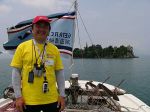
Masaki "Follow Me" Unose on the lead boat going to Takeshima island.
|
|

Takeshima is a small island with only Nichiren Buddhist temple and the priest's family living on the island. Accessible by boat from Hikone, Shiga Prefecture.
|
|

The island is noted for its giant stone monument inscribed with the prayer words "Namu Myo-horenge-kyo" from the Lotus Sutra.
|
|

Takeshima means "Island of Many Views" because it looks dramatically different from different angles.
|
|
|
|

Approaching Satsuma Beach, the final stop for the day.
|
|

Approaching Satsuma Beach.
|
|

Satsuma Beach in Hikone.
|
|

Hot rowers in a cool Lake Biwa.
|
|
|

Inokashira Park once only had rowboats.
|
|
|

In Aug. 2006, a local NPO called the Takashima-Imazu Rowing Club restarted the Imazu Regatta with the support of the rowing clubs from Imazu Junior High School and Takashima High School.
|
|

The regatta race course was 500 meters long off the Imazu Nakahama and Ichigasaki shore. It had four rowing lanes. 今津中浜〜市が崎沖合
|
|

The finish line was in front of the Sunbridge Hotel seen here. It was a nice, sunny, and calm day for a regatta. レガッタのBGMは「琵琶湖周航の歌」英語版。
|
|

Finish line. It cost only 500 yen (insurance) to race in the regatta. You do not have to form a rowing team to participate. Single individuals could also register to race in the regatta.
|
|

There were four racing categories: 1. Junior and high school students, 2. General public (beginners or experienced), 3. Rowing club alumni and experienced rowers, and 4. Combination of 2 and 3.
|
|

Five types of boats were provided: Single scull, double scull (shown here), quadruple with cox, ocean scull, and fixed-seat boats.
|
|

Quadruple with cox. This boat belongs to the NPO. The races were separate for men and women.
|
|

Quadruple with cox going to the start line.
|
|

The regatta's main objective is to have more people try rowing as a sport.
|
|

Regatta starting line. By hosting a regatta, the local junior high and high school kids can learn about the hard work that goes behind a regatta.
|
|

The other quadruple with cox boat.
|
|
|

Ready to race.
|
|
|

Quadruple race
|
|
|
|
|

Single scull
|
|

Women's single scull
|
|

Imazu Junior High School students
|
|
|
|

Starting line
|
|

Imazu Junior High School students start the race.
|
|
|
|
|

Imazu Junior High School female students rowing in the 3rd Imazu Regatta.
|
|

Imazu Junior High School female students rowing in the 3rd Imazu Regatta. Also see my YouTube video here.
|
|

Imazu Junior High School female students rowing in the 3rd Imazu Regatta.
|
|

Imazu Junior High School female students rowing in the 3rd Imazu Regatta.
|
|
|
|
|

Near the finish line.
|
|
|

Finish line.
|
|

Fixed-seat boat race.
|
|

Fixed-seat boat race. フィックス艇
|
|
|

Mt. Ibuki in the background with fixed-seat boat racing. The Lake Biwa Rowing Song was also played as the regatta's background music.
|
|

Chikubushima in the background with fixed-seat boat racing.
|
|
|
|
|

Imazu shore
|
|

Nice new quadruple boat owned by the Takashima-Imazu Rowing Club NPO.
|
|

Nice new quadruple boat owned by the Takashima-Imazu Rowing Club NPO.
|
|
|

I got to row in this quadruple boat.
|
|

We rowed the boat to near the boathouse. It was a spanking-new boat, and felt good.
|
|

Carrying the boat to shore.
|
|

Imazu Junior High School Rowing Club banner and members going to the regatta's awards ceremony.
|
|
|

Swan boat and a real swan.
|
|

Swan boats. You can pedal pretty far out in these things, but not to the Nakajima islands.
|
|

On the shore of Lake Toya is binoculars through which you can see the Summit venue, the Windsor Hotel.
|
|

Swan boats again.
|
|

One of Otsu's Big Three Festivals, the Senko-sai is a portable shrine procession on boats going down Seta River from Seta-no-Karahashi Bridge to Nango sluice and back. Held annually on Aug. 17 by Takebe Taisha Shrine. The festival starts at 5 pm.
|
|

Seta-no-Karahashi Bridge had four bamboo poles indicating where the mikoshi (portable shrine) boats will pass under. These photos were taken on Aug. 17, 2010, a very hot day. MAP
|
|

Sign says that people cannot enter the middle section of the bridge under which the mikoshi will pass.
|
|
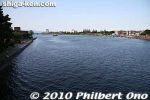
The Senko-sai festival personifies the marine journey of legendary prince and warrior Yamato Takeru. It also prays for water safety. Yamato Takeru is one god Takebe Taisha Shrine worships.
|
|

The east bank of Seta River near Seta-no-Karahashi Bridge.
|
|

The two mikoshi boats have dragon heads.
|
|

More boats to be in the procession.
|
|
|

Pier scene near Seta-no-Karahashi Bridge.
|
|

Mikoshi boats await the mikoshi.
|
|

These two cruise boats (Lansing and Interlaken) were chartered for the festival.
|
|

Seta-no-Karahashi Bridge.
|
|

The festival started at 5 pm when the mikoshi (portable shrine) procession departed Takebe Taisha Shrine about 500 meters from the east end of Seta-no-Karahashi Bridge.
|
|

The procession arrived at the east end of Seta-no-Karahashi Bridge at about 5:15 pm.
|
|

Even though this is one of Otsu's Big Three Festivals (others are Sanno-sai and Otsu Matsuri), the crowd watching was surprisingly sparse.
|
|
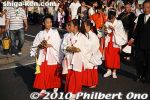
Shrine maidens
|
|

Archer
|
|

First was a children's mikoshi (portable shrine).
|
|

Followed by another children's mikoshi.
|
|
|
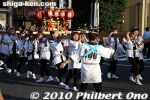
The third mikoshi was carried by women.
|
|
|
|
|

Nagata Megumi, Biwako Otsu Tourist Ambassador for 2010, was also in the procession. 永田めぐみ
|
|

The two Biwako Otsu Tourist Ambassadors for 2010. びわ湖大津観光大使:井上まどか、永田めぐみ
|
|

Escorted by taiko drummers, the main mikoshi arrives at the east end of Seta-no-Karahashi Bridge.
|
|
|

They do a few maneuvers with the main mikoshi.
|
|
|
|
|
|
|

The mikoshi carried by the ladies is loaded onto the boat.
|
|

The main mikoshi arrives at the boat pier.
|
|

Heading for the boat.
|
|

Carrying the main mikoshi to the boat.
|
|

Hauling the main mikoshi onto the boat.
|
|
|
|
|

The two Biwako Otsu Tourist Ambassadors for 2010, Inoue Madoka and Nagata Megumi. Selected from among 21 applicants in April 2010. For one year, their job is to promote tourism in Otsu. びわ湖大津観光大使:井上まどか、永田めぐみ
|
|
|

All the mikoshi are loaded up on the boats and ready to go.
|
|
|

Boat pier north of the east end of Seta-no-Karahashi Bridge. This is where the crowd was concentrated. People gave a few speeches before the boats left.
|
|
|

The main mikoshi all set on the boat.
|
|

The boat with the three mikoshi aboard is pulled away by tugboat.
|
|
|

Next, the boat carrying the main mikoshi is taken upstream.
|
|

The main mikoshi on the boat during the Senko-sai festival on Setagawa River in Otsu.
|
|

The three mikoshi head upstream.
|
|

All the boats first head upstream toward Lake Biwa, then they make a U-turn and sail downstream down Seta River.
|
|
|

The fireworks barge can be seen on the distance.
|
|

Lansing going to rendezvous with the other boats. Most of Lake Biwa's cruise boats are named after Shiga's sister states (like Michigan) or cities. Lansing is in Michigan.
|
|
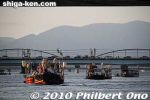
After making a U-turn, the boats head downstream toward Seta-no-Karahashi Bridge.
|
|

The crowd watching the boat procession was sparse. It seems most people were waiting for the fireworks instead. It was a hot day too.
|
|
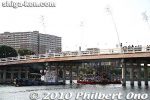
Heading the boat procession is the main mikoshi now passing under Seta-no-Karahashi Bridge.
|
|

Boat with the main portable shrine pass under Seta-no-Karahashi Bridge.
|
|
|

Boat with the main portable shrine pass under Seta-no-Karahashi Bridge.
|
|
|
|
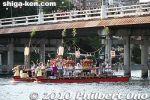
Boat with the three portable shrines pass under Seta-no-Karahashi Bridge.
|
|

Boat with the three portable shrines pass under Seta-no-Karahashi Bridge.
|
|

Other boats follow. They all proceeded to the shrine's Otabisho near the Nango sluice on Seta River. A Shinto ceremony would be performed there before they returned back to Seta Karahashi Bridge at 8 pm.
|
|

A yakata-bune shrine boat passes under Seta-no-Karahashi Bridge. This festival reminded me of the Tenjin Matsuri in Osaka, but on a smaller scale.
|
|

Interlaken passing under Seta-no-Karahashi Bridge.
|
|
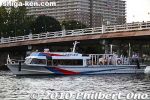
Lansing passing under Seta-no-Karahashi Bridge.
|
|

By 6 pm, all the boats left and we would have to wait 2 hours to see the fireworks when they returned. Unfortunately, I couldn't stand the heat and left. Perhaps I'll see the fireworks someday.
|
|

Senko-sai video (embedded).
|
|
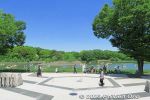
After entering the park through the Nishi-Tachikawa Entrance, you see this scene of the Waterfowl Pond and pedal boats. 水鳥の池
|
|

Pedal boats are very popular. This is the boat dock.
|
|

Long line to buy tickets for the pedal boats. This was during Golden Week in early May 2023.
|
|

On the shore of Lake Toya is binoculars through which you can see the Summit venue, the Windsor Hotel.
|
|

The Nagaragawa River ukai cormorant fishing is held nightly from May 11 to Oct. 15 except during the Full Moon and if the river overflows. You can buy tickets and board the viewing boats here, next to Nagarabashi Bridge. 鵜飼観覧船のりば
|
|

Although there is cormorant fishing in other parts of Japan, Gifu's Nagara River ukai cormorant fishing is most famous because it is connected to the Imperial family. Statue of a ukai cormorant fishing master called an "usho." 鵜匠の像
|
|

Ticket office for ukai cormorant fishing viewing boats. Behind it is Nagara River and boat dock. You can buy tickets on the day you want to view the cormorant fishing. Pamphlets in English are available. 鵜飼観覧船事務所
|
|

You have several options: Course/Cruise A is slightly more expensive (3300 yen) than Course B (3000 yen) since it allows you to be on the boat for a longer time. The 6:15 pm departure time is earlier, so it gives you time to eat dinner on the boat.On weekends and holidays, the 3300 yen price is the same for both Course A and B.
|
|

You can bring your own food and drinks on the boat. Next to the ticket office is this stone moument for a TV program which declared a song about Nagara River ukai cormorant fishing to be a national favorite for many years.
|
|

Ukai-related poems. There's even one composed by Basho: おもしろうて やがて悲しき 鵜飼かな。 Gifu's Nagara River ukai cormorant fishing has a 1300-year history. It is recorded in the Nihon Shoki (Chronicle of Japan) and Kojiki
|
|

Boat harbor for ukai viewing boats. The two boats in the foreground are restroom boats. Ukai cormorant fishing is a traditional fishing technique all but replaced by more advanced fishing methods. So it is now mainly for tourists.
|
|

Restroom boat. During the cormorant fishing, this toilet boat is parked near the viewing boats for your convenience.
|
|

Ukai cormorant fishing viewing boat. You don't need to go as a group. You can go by yourself and just ride with other passengers. There are also boats for women only, families only, and couples only.
|
|

If you have a group of 15 or more, it would be cheaper to charter a boat to view the cormorant fishing. Some of the viewing boats are also handicapped-accessible.
|
|

Dancing boat where dancers entertain people before the ukai fishing. 踊り舟
|
|

At the boat dock (next to Nagarabashi Bridge) at 5:45 pm, one of the six ukai cormorant fishing masters give a short talk about ukai fishing. The crowd gathers for the talk.
|
|

Ukai cormorant fishing master Sugiyama Ichisaburo comes to give the ukai talk. The basket has two cormorant birds. Nagara River in Gifu has six ukai cormorant fishing masters. All of them appear nightly. 杉山市三郎
|
|

First he explains about the fishing master's costume, starting with his cap (kazaori-eboshi) made of hemp cloth. It's actually a flat piece of black or navy blue cloth wrapped around his head to protect his hair from the fire. 風折烏帽子
|
|

The cap protrudes upward to make room for the topknot which the men used to have in the old days. His shirt (ryofuku) is made of cotton. He also has a fire-protection vest (muneate) that has a pocket. 漁服(りょうふく)胸あて(むあて)
|
|

His footwear is a pair of half-slippers (ashinaka) made of straw (handmade by the fishing master). It is half the usual length. It prevents him from slipping on the fish oil and water. 足半(あしなか)
|
|

He took out one of the cormorants from the basket cage. In Japanese, the bird is called umi'u. They normally fish in the ocean as opposed to the kawa'u river cormorant which are smaller and have been devastating to the fish in Lake Biwa.
|
|

He puts in ayu sweetfish into the cormorant's mouth. Nagara River's six cormorant fishing masters are employees of the Imperial Household Agency (Ceremonies Dept.). They are national government employees. 海鵜
|
|

There is a ring around the bird's throat, preventing it from swallowing the fish. (The bird can still swallow smaller fish.) The cormorants are caught in the wild in Hitachi, Ibaraki Prefecture and trained for ukai fishing in Gifu. 鵜
|
|

The bird then spits out the fish. The person on the right is the fishing master's son being groomed to take over his father's job. The fishing master has been doing this for 50 years. It is a hereditary position and occupation. 鮎
|
|

The fishing master's handmade skirt (koshimino) is made of straw. It functions as a raincoat and provides warmth. He makes and wears out four or five skirts each year. Underneath is just shorts. 腰蓑(こしみの)
|
|

The ukai fishing master's ukai cormorant fishing boat is called ubune. Accompanied by an assistant (middle) called the nakanori and the steerer (at rear) called tomonori. About 13 meters long. 鵜舟(うぶね)= 鵜匠+供乗り(とものり)
|
|

After the ukai talk, passengers start to board the ukai viewing boats at 6:15 pm. Course B passengers will board at 6:45 pm or 7:15 pm. Course B is for people who just want to see the cormorant fishing, and don't care to spend much time on the boat.
|
|

With passengers aboard, the boats depart one after another, heading upstream.
|
|

The viewing boats are called yakata-bune. They come in different sizes. 屋形船
|
|

The smaller yakata-bune, like this one, is human-powered.
|
|

The larger yakata-bune has a silent, battery-powered outboard motor. Notice the solar panels on the roof. 屋形船
|
|

Ukai viewing boats head upstream to where the boats are parked next to the river shore.
|
|

If you're staying at a hotel or ryokan in Gifu city, it's possible to have your hotel arrange the viewing of the cormorant fishing. I went to see ukai cormorant fishing through a luxury hotel on the river. The dock was a short walk from the hotel.
|
|

Mt. Kinkazan, topped with Gifu Castle, is a prominent sight on Nagara River. 金華山
|
|

Ukai viewing boats going upstream with Mt. Kinkazan in the background. The castle is also lit at night.
|
|

Nagara River 長良川
|
|

Boats awaiting passengers. We call them yakata-bune. The roof is shaped like a house roof. 屋形船
|
|

Inside one boat. The floor has tatami mats. A low table is also provided. No dinner provided on this boat.
|
|

This is our ukai viewing boat called Dosan Maru, named after the famous lord of Gifu. All the ukai viewing boats have a name related to the Gifu area, Nagara River or ukai fishing. Notice the bento boxes. 道三丸
|
|

After they took our picture in front of the boat (and later charged 1,000 yen for a 5x7 in. print), we started to board the large boat.
|
|

Nagara River, looking upstream. We departed at about 6:30 pm. 長良川
|
|

Our boat was semi-human powered. I think this guy should be wearing a happi coat and a Chinaman's hat for better atmosphere and aesthetics.
|
|

Mt. Kinkazan
|
|
|
|